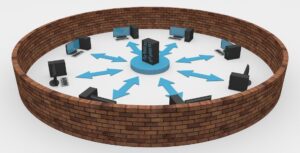
Bottom Up: LA’s Industrial Base
Considering its size, complexity, and global reputation, it’s not a surprise that metropolitan Los Angeles attracts more business, industry, innovation, and talent than virtually any other city in the world. Providing a skilled, well-trained workforce to fill those millions of jobs is a challenge, however. That’s why the ‘workforce development’ sector is as significant a player in the region’s economy as are all those businesses. And the many California Community Colleges (CCC) that dot the geography are at the center of that workforce development universe.
Seven Major LA-Region Industries
The Los Angeles ‘region’ is more than just the County and City of Los Angeles. It actually includes 88 cities and all of Orange, San Bernardino, Riverside, and Ventura counties and is home to 19+ million people and about a quarter of a million businesses. It’s also one of the world’s most influential cities due to the depth, breadth, and scope of its industrial base. Just its two major shipping ports can generate more than $1 billion in a single day.
However, despite the immense variety of its businesses, several specific industrial sectors act as major hubs through which other industrial subsectors emerge. A 2013 study done by the Los Angeles Economic Development Corporation (LAEDC), determined that seven primary industries are foundational to the region’s economy. They not only engage large workforces currently but they are also expected to experience ‘high growth’ as they expand into the future:
Construction,
Transportation and logistics,
Manufacturing,
Bioscience,
Hospitality and tourism, and
‘Professional services’ (which includes its immense entertainment complex).
Consequently, the State government has based its economic and workforce development strategy on supporting and assisting these industries. It emphasizes their significance when aligning its workforce training efforts with its state-school (CCC) educational objectives and initiatives.
Four Major LA Sub-industries
Four sub-industries within the larger sectors are especially relevant, as they offer the best outlook for sustained growth and longevity:
Aerospace & Defense
These LA-based businesses employ over 90,000 workers directly and engage more than a quarter-million more in related side and supply chain activities. As the name implies, ‘space’ exploration is a key focus, as is defense systems development, creation, and implementation. These companies provide the creativity, engineering, and manufacturing resources needed to drive America’s immense defense networks and lead the world into the sky. They need a workforce capable of engaging with their current projects and trained sufficiently to build those that are coming next. Military experience is not required (in most cases).
Advanced Transportation & Cleantech
In this case, ‘advanced transportation’ includes introducing and developing autonomous and electric-powered vehicles and all the accouterments that go along with that evolving industry. Notably, while the region isn’t known for its vehicle manufacturing specifically, it is accepted as a global hub for the research and development, design, and engineering that creates the foundation for the world’s cars, trucks, and other vehicles.
Further, given the area’s spectacular climate and environmentally friendly population, ‘clean tech’ rides – non-polluting, low-carbon emission transportation – are also significant to this industry. Consequently, the region is also growing its clean and green businesses and industries to support its early adoption of these newer, ‘greener’ transportation options. Demand for a well-trained workforce in these companies and enterprises continues to grow.
Life & Biosciences
At the heart of this vital industry is California’s unmatched university system, which trains the researchers and scientists it needs to unlock the secrets of today’s most pressing health issues. With their insights and creativity, the sector pumps out the research that drives vaccine development, life-altering cancer treatments, advanced surgery techniques and strategies, among thousands of other health, medical, and bioscience resources.
In addition to direct health-related research done at the schools and their affiliated labs, bioscience companies also align their activities geographically by establishing ‘cluster parks’ close to the hospitals, clinics, and other facilities that will assist in advancing their work. With the explosion of health-specific technology, this industry is experiencing extreme growth and is always in need of a middle- and highly skilled workforce.
Digital Media & Entertainment
This IS LA, after all, the center and heart of the world’s entertainment industry. However, that industry has grown well beyond its ‘moving picture’ origins and now encompasses – literally – any and all real and virtual creative formats for movies, television, music, the arts, digital gaming, virtual reality, and more.
While the ‘big names’ are still globally familiar (20th Century Fox, Paramount Pictures, Sony, etc.), this industry is mostly comprised of thousands of smaller businesses, entities, and individuals, all of whom contribute to its bigger economic picture. This ‘creative’ economy’ supports all facets of imaginative generation, from original ideas to fully developed productions. Each stage along that continuum requires a well-trained worker to bridge the gap between what’s been created and what needs creating. The resulting economic base contributes significant revenues into state and local treasuries.
LA Industry Organizations
It takes an immense volume of teamwork to harness the vast swath of opportunity presented by the LA region’s industrial base. Two notable commercial and economic groups have convened to identify what that work is and strategize how to accomplish it.
The Los Angeles Economic Development Corporation (LAEDC)
This think tank non-profit combines the talents of economists, analysts, business leaders, advisors, and public policy wonks to evaluate the impacts of time, innovation, pandemics(!), and other influences on the region’s economic inputs and outputs. The digital age has already disrupted the traditions and practices of several industries and will certainly do the same on many more. Automation, artificial intelligence (AI), machine learning (ML), and other innovations are forcing businesses to rethink their business model, which triggers a chain reaction across industries and workforces. Finding solutions to these evolving challenges that respect both the organization’s ‘bottom line’ and its human resources needs is at the heart of this agency’s work.
The LAEDC also works in conjunction with other, similar regional work-related councils and partners, each of which adds insights and contributions derived from its own unique geography and constellation of industries.
In addition to these regional economic development agencies, the Greater Antelope Valley Economic Alliance, the San Gabriel Valley Economic Partnership, the Santa Clarita Valley Economic Development Corporation, and the Valley Economic Alliance, the LAEDC also works with numerous strategic partners that represent the wide variety of ethnicities, industries, disciplines, and interests that make up the thriving LA economic and social culture.
PCC EWD: At the Center of All the Action
The Pasadena City College Economic and Workforce Development department (PCC EWD) represents the nexus where these economic and industrial theorists meet up with their boots-on-the-ground practitioners. The PCC EWD melds together the directives of the State government and the California Community Colleges Chancellor’s Office (CCCCO) and the demands of its business and industry neighbors. To address those competing influences, the EWD conducts its activities through five ‘pillars,’ each of which represents an individual facet of the larger economic development puzzle:
Achieving Student Success
The Robert G. Freeman Center for Career and Completion
This on-campus facility provides the support students need to accomplish a successful educational journey and find their chosen career.
Facilitating Work-based Learning
Located within the Freeman Center, this initiative connects student learners with businesses and companies that both need workers and are invested in offering on-the-job training.
Supporting Small Businesses
The Small Business Development Center offers guidance and counseling on all things ‘business.’ Its experienced counselors and advisors can help both startups and established entities overcome hurdles and build towards a more profitable future.
Providing Workforce Development Support
As a partner to those businesses, the PCC EWD also acts as a training center, providing the inputs they need (facilities, materials, etc.) to re-train or upskill their existing workforce. This partnership reduces the business costs associated with training while enhancing the educational capacity of the school.
Offering Education for All
The PCC EWD Extension offers learning opportunities for any learner, whether their objective is to find a job or just learn something new.
With these five pillars in place, fully functional and gearing for life after COVID, the PCC EWD is well situated to embrace the businesses in its community and support them through the challenges they are about to encounter.
Los Angeles is one of the world’s major industrial centers, made up of thousands of businesses and populated with millions of talented, resourceful, and innovative workers. The many regional community colleges act as the workforce development resource for these industries and contribute the workers that drive the economy. In the East LA region, the PCC EWD is playing its part in this intricate dance, pursuing state and college mandates while responding to the needs of its students and its local business community.


